It all started because a giant praying mantis crawled up the side of a parked car. That small creature helped spark a big idea because now a new wildflower garden is in full bloom in its first summer in the “backyard” of the Schaap Science Center.
While the garden beautifies another corner of an already-beautiful Hope campus, and while it attracts and supports wildlife in a 13-meter by 5-meter space, it is also producing a primary unique crop. This garden is the foundation for research on curriculum about nature-based learning.
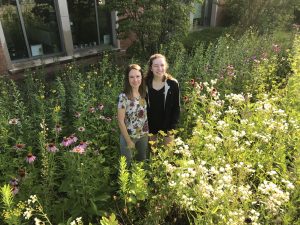
“My colleague Ginny McDonough knows I love insects, and she saw this giant praying mantis on her car one day last year in the Schaap parking lot,” says Dr. Vanessa Muilenburg, entomologist and assistant professor of biology. “We started talking about the mantis and about where it came from and about that area in back of Schaap. We were observing that it was a kind of desert out there (because of the monoculture of plants formerly there). There’s no habitat for native animals, including insects and pollinators.”
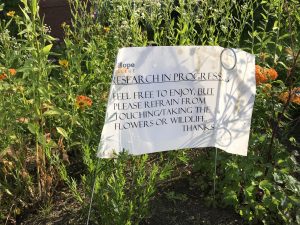 So, Muilenburg decided to do something about it. First, she enlisted the help of members of the Hope’s grounds crew last summer to rip out Schaap’s current backyard groundcover – Liriope spicata, or lily flower — a non-native, invasive plant which is used in steep areas to control erosion. “We had to bring in a sod cutter because it’s so thick,” she said. “Our grounds crew did a great job to take it out including the whole root system. Occasionally now, a few new liriope plants have popped up over time so we have to watch and pull them out. They can grow just from a little bit of root. That’s why it’s invasive.”
So, Muilenburg decided to do something about it. First, she enlisted the help of members of the Hope’s grounds crew last summer to rip out Schaap’s current backyard groundcover – Liriope spicata, or lily flower — a non-native, invasive plant which is used in steep areas to control erosion. “We had to bring in a sod cutter because it’s so thick,” she said. “Our grounds crew did a great job to take it out including the whole root system. Occasionally now, a few new liriope plants have popped up over time so we have to watch and pull them out. They can grow just from a little bit of root. That’s why it’s invasive.”
The long process of cultivating, planting, waiting, tending and then watching a garden grow has birthed more than colorful blooms this summer; it bore a habitat for pollinators, insects and other small animals that nourish the area. It also is now bearing elementary-school science curriculum.
By last July, Muilenburg had the ground prepared for future purple and yellow coneflowers, butterfly weed, common milkweed, prairie coreopsis, wild columbine, and golden alexanders. By this spring, 1000 small plants from the Schaap Center greenhouse, as well as from seeds, had taken root and the new plants have been carefully nurtured by sophomore biology major Cameryn Veine. The long process of cultivating, planting, waiting, tending and then watching a garden grow has birthed more than colorful blooms this summer; it bore a habitat for pollinators, insects and other small animals that nourish the area. It also is now bearing elementary-school science curriculum.
“Nature-based learning has shown that it has many, many benefits for children,” said Veine of outcomes such as increased ability for children to attend to task, increased motor skill development, and more varied social and nature interactions. “And there are these new science standards that really encourage young students to act like scientists. That really pairs well with our wildflower garden. So basically, we’re using what we find and observe in this wildflower garden to write kindergarten through fifth grade curriculum.”
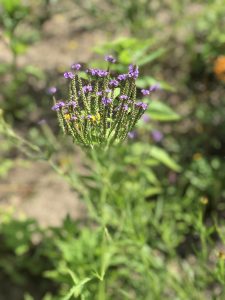 Veine and Muilenburg have worked closely with Dr. Stephen Scogin, Hope’s expert on biology education, in creating their nature-based learning curriculum. InnoAcademy in Zeeland is the first to field-test it. Other local schools are welcome to use it, too. Since many schools don’t have the resources to go on field trips to experience nature-based learning, Muilenburg and Veine want to bring it to them in an easy-to-maintain system.
Veine and Muilenburg have worked closely with Dr. Stephen Scogin, Hope’s expert on biology education, in creating their nature-based learning curriculum. InnoAcademy in Zeeland is the first to field-test it. Other local schools are welcome to use it, too. Since many schools don’t have the resources to go on field trips to experience nature-based learning, Muilenburg and Veine want to bring it to them in an easy-to-maintain system.
“Native plants have evolved to live here and thrive with no maintenance,” Muilenburg explained. “So, our hope is to establish native plant gardens on schools’ grounds and to provide a curriculum that they can use to investigate scientific questions that they see in their own gardens.”
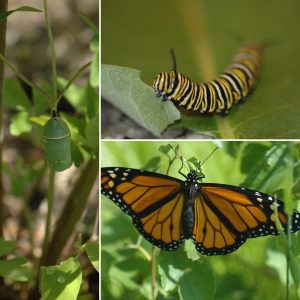
As Veine has conducted most of the observational transects of the garden this summer, she has seen an overwhelming amount of new, thrilling life. Honeybees. Flies. Chrysalis. Caterpillars. Butterflies. The sheer number of monarchs alone has dramatically increased with 89 observed over six-week period, a drastic increase considering they probably weren’t there before. “I have seen the garden grow over time because I started with Dr. Muilenburg in early May,” said Veine, “and it’s so much thicker now. We are even having trouble navigating through it. So, just being able to see it grow up is pretty cool. I’m pretty proud.”
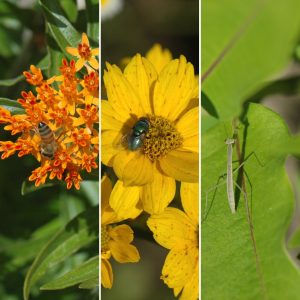
For Muilenburg, there is great satisfaction in watching wild things grow and live and thrive. That includes the young children who will now come in contact with the curriculum she and her garden colleagues created. It also includes praying mantises that started this whole thing in the first place.
“We’ve observed lots and lots of baby praying mantis out there,” Muilenberg says, grinning with genuine gladness. “That’s been really cool and fun to see this come full circle.”
—
Photo credits: Vanessa Muilenburg, Cameryn Veine, Greg Olgers, Eva Dean Folkert


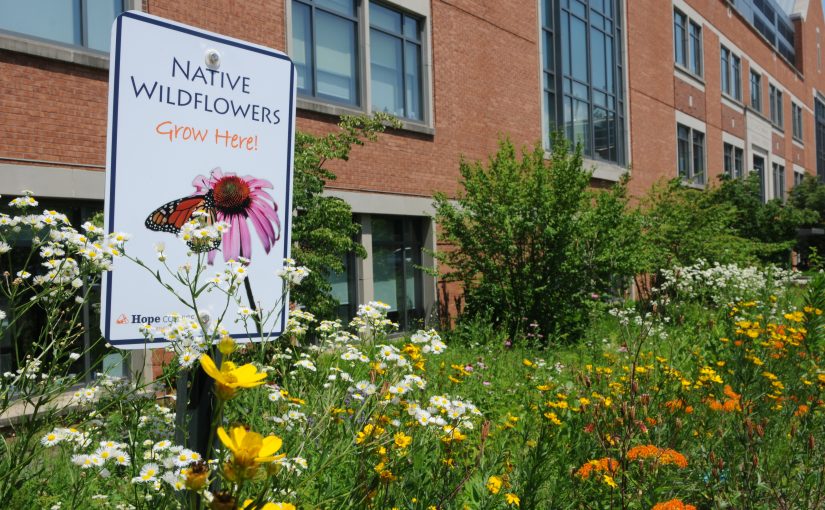
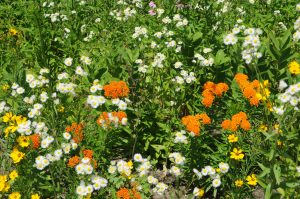
I LOVE this garden of beautiful, native flowers that grace us with so much beauty and wonderful living creatures! A calming invite to all who take the time to stop the rush, look and watch.
Loved reading this. Do you help others start similar gardens by any chance?